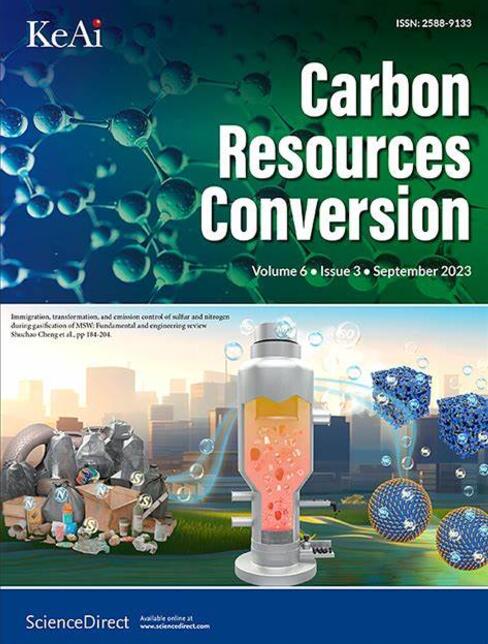One step preparation of papyrus culm derived activated biochar using partial air oxidation and its use as a filter for water treatment in aquaponics culture
IF 7.5
3区 环境科学与生态学
Q2 ENERGY & FUELS
引用次数: 0
Abstract
Papyrus culm derived activated biochars were prepared through carbonization and air oxidation at 400–600 °C. The activated biochars were analyzed by SEM-EDS, FT-IR, Raman, BET, and XRD techniques. The best product was collected for use as filter material in aquaponics. It was found that the activated biochars have diverse properties with high disorder of graphitic, oxygenated functional groups (OH, C=O, C-O, and Si-O), oxide compounds (CaO, MgO, Na2O, K2O, SiO2), and relatively high specific surface area and micropore volume. These parameters increased with increasing carbonization temperature from 400 °C to 600 °C. For materials produced at 600 °C the pore size of the derived activated biochar falls in the range of micropores (<2 nm), with a small mesopore and macropore content. This product has BET specific surface area of 270.27 m2/g. Utilizing the derived activated biochar prepared with carbonization at 600 °C for aquaponics culture has shown that the values of total NH3, NO2–, NO3–, PO43-, and turbidity decreased, while the DO content increased in the water of the aquaponics culture with efficiency percentage values of 33.33–35.90 %, 4.93–13.43 %, 9.15–12.90 %, 34.97–43.04 %, 10.23–23.90 %, and 16.86–23.90 %, respectively, throughout the four weeks of the experiment. This was achieved via electrostatic attraction, exchangeable cation and anion attraction, and filtration. Furthermore, the activated biochar could also maintain the water pH in a relatively alkaline range for the duration of the experiment, which is suitable for cultivating tilapia and growing red oak lettuce. However, the activated biochar filter began to reach sorption saturation during the third week of the experiment. Therefore, the activated biochar filter should be replaced with a new one after four weeks of use. This research has shown that activated biochar from papyrus culm can be a candidate for an adsorbent material with a simple, cost-effective, and timesaving production.

部分空气氧化法一步制备纸莎草草衍生的活性生物炭及其在水培培养中作为水处理过滤器的应用
通过400 ~ 600℃的炭化和空气氧化法制备了纸莎草草源活性生物炭。采用SEM-EDS、FT-IR、Raman、BET、XRD等技术对活性炭进行分析。收集最佳产物作为水培工艺的滤料。结果表明,活性炭具有石墨、氧合官能团(OH、C=O、C-O和Si-O)、氧化物(CaO、MgO、Na2O、K2O、SiO2)的高度无序性,具有较高的比表面积和微孔体积。这些参数随着炭化温度从400℃升高到600℃而增加。在600℃下制备的活性生物炭的孔径在微孔(2nm)范围内,中孔和大孔含量较少。本品BET比表面积为270.27 m2/g。利用600℃炭化制备的衍生活性生物炭进行水培培养,结果表明,在4周的实验过程中,水培培养水体中总NH3、NO2 -、NO3 -、PO43-和浊度降低,DO含量增加,效率百分比分别为33.33 - 35.90%、4.93 - 13.43%、9.15 - 12.90%、34.97 - 43.04%、10.23 - 23.90%和16.86 - 23.90%。这是通过静电吸引、可交换的阳离子和阴离子吸引和过滤来实现的。此外,活性炭还能在试验期间将水体pH维持在一个相对碱性的范围内,适合养殖罗非鱼和种植红橡树生菜。然而,活性生物炭过滤器在实验的第三周开始达到吸附饱和。因此,活性生物炭过滤器应在使用四周后更换新的。本研究表明,从纸莎草秆中提取的活性生物炭可以作为一种简单、经济、省时的吸附材料。
本文章由计算机程序翻译,如有差异,请以英文原文为准。
求助全文
约1分钟内获得全文
求助全文
来源期刊

Carbon Resources Conversion
Materials Science-Materials Science (miscellaneous)
CiteScore
9.90
自引率
11.70%
发文量
36
审稿时长
10 weeks
期刊介绍:
Carbon Resources Conversion (CRC) publishes fundamental studies and industrial developments regarding relevant technologies aiming for the clean, efficient, value-added, and low-carbon utilization of carbon-containing resources as fuel for energy and as feedstock for materials or chemicals from, for example, fossil fuels, biomass, syngas, CO2, hydrocarbons, and organic wastes via physical, thermal, chemical, biological, and other technical methods. CRC also publishes scientific and engineering studies on resource characterization and pretreatment, carbon material innovation and production, clean technologies related to carbon resource conversion and utilization, and various process-supporting technologies, including on-line or off-line measurement and monitoring, modeling, simulations focused on safe and efficient process operation and control, and process and equipment optimization.
 求助内容:
求助内容: 应助结果提醒方式:
应助结果提醒方式:


